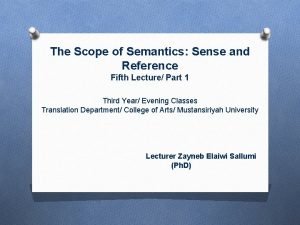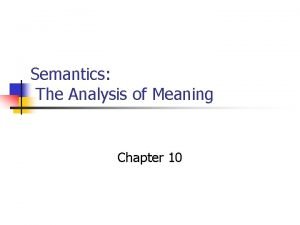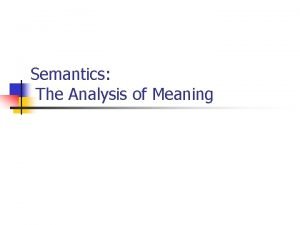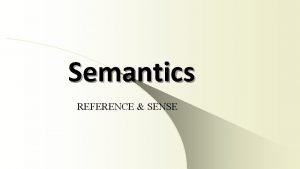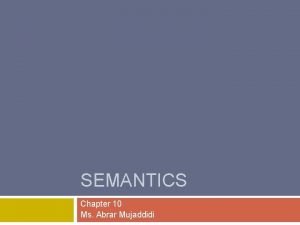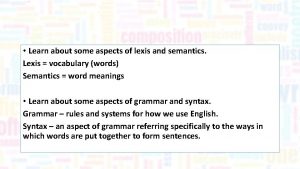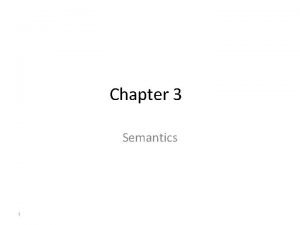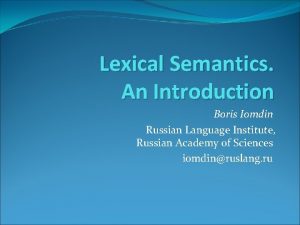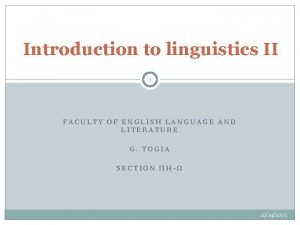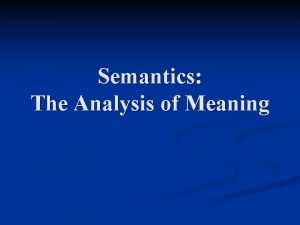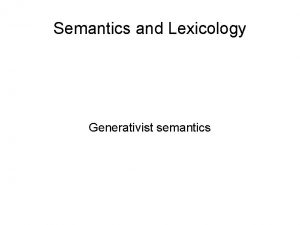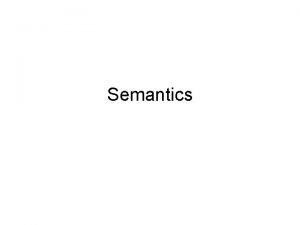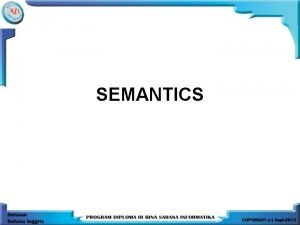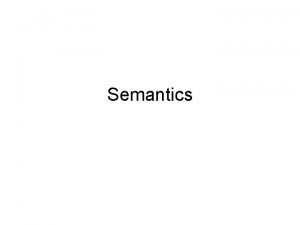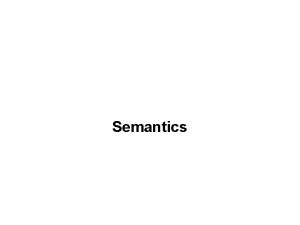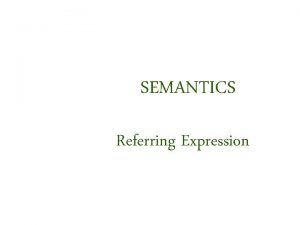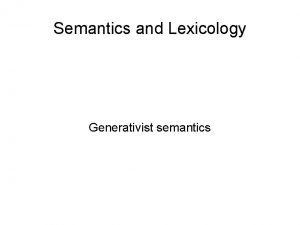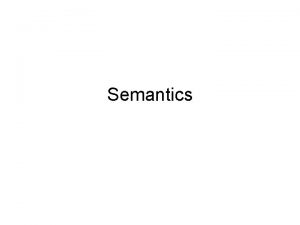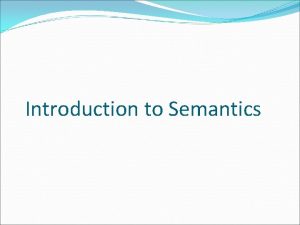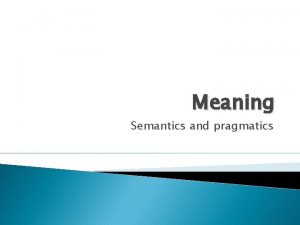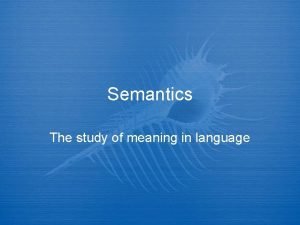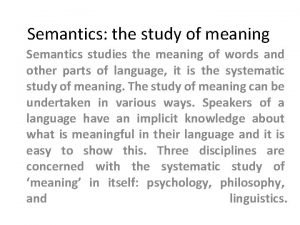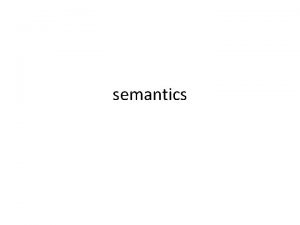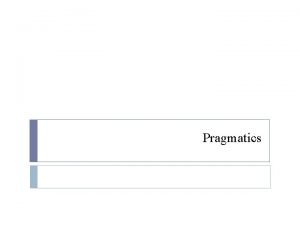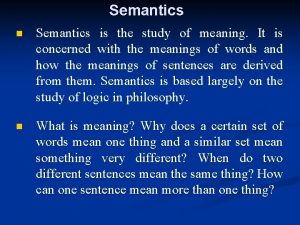Semantics The Analysis of Meaning Chapter 10 Meaning





















- Slides: 21

Semantics: The Analysis of Meaning Chapter 10

Meaning n To understand language n n n the meaning of words and of the morphemes that compose them Words into phrases and sentences Context which determines the meaning (Pragmatics)

What is Semantics? n The study of meaning of words, phrases, and sentences. n n n Lexical semantics (words and meaning relationship among words) Phrasal/ sentential semantics (syntactic units larger than a word) What a speaker conventionally means (objective or general meaning)- not what he is trying to say (subjective or local meaning)

How can we describe the meaning of different words? n Three types of semantic analysis: n n n Words as ‘containers’ Semantic features ‘roles’ they fulfill Semantic roles ‘relationship’ with other words lexical relation

Semantic Features n n n Semantic properties: The components of meaning of a word. Meaning as collection of properties/features typically with two possible values (+ / -) Example of componential analysis: baby is [+ young], [+ human], [+animate]

Semantic Features

Identify the features (1) (a) widow, mother, sister, aunt, maid 1. (b) widower, father, brother, uncle à à à The (a) and (b) words are [+ female] The (a) words are [+ male] The (b) words are [+ human] 2. (a) bachelor, paperboy, pope, chief (b) bull, rooster, drake, ram à à à The (a) and (b) words are The (a) words are The (b) words are [+ male] [+ human] [+ animal]

Semantic roles n Words are described according to the roles they fulfill with the situation described in a sentence. n n The boy kicked the ball n verb indicates action n Boy performs the action= agent n Ball undergoes the action= theme The NPs describe the role of entities (people or things) involved in the action, i. e. they have certain semantic (or thematic) roles.

Semantic Roles n n Agent= the entity that performs the action Theme= the entity that undergoes the action Experiencer= one who perceives something Instrument= an entity used to perform an action n Location= the place where the action happens Source= the place from which an action originates Goal= the place where the action is directed

Semantic roles n John is writing with a pen agent n Mary saw a mosquito on the wall experiencer n n instrument themelocation The children ran from the playground to the pool agent source The boy opened the door with a key The dog bit the stick With a stick, the man hit the dog. goal

Lexical relations n What is the meaning of ‘big’? n n What is the meaning of ‘daffodil’? n n ‘Large’ or the opposite of ‘small’ A kind of flower Analysis in terms of lexical relations- explain the meaning in terms of the relationship with other words n n n Synonymy Antonymy Hyponymy Prototype Homophones and Homonyms Polysemy

Synonymy n n Synonymy: words that have the same meanings or that are closely related in meaning E. g. answer/reply – almost/nearly – broad/wide – buy/purchase – freedom/ liberty ‘sameness’ is not ‘total sameness’- only one word would be appropriate in a sentence. n E. g. Sandy only had one answer correct on the test. (but NOT reply) Synonyms differ in formality n E. g buy/purchase – automobile/car

Antonymy n Antonymy: words that are opposites in meaning, e. g. hot & cold. n Types n Gradable= not absolute, question of degree n n Hot & cold – small & big Non-gradable: n Dead & alive – asleep & awake E. g. happy/sad present/absent married/single fast/slow

Synonymy & Antonymy Synonymy or Antonymy n Flourish – thrive n Intelligent – stupid n Casual – informal n deep-profound n Drunk – sober n Sofa – couch n Hide – conceal n cheap – expensive n Rich - wealthy a. b. c. d. e. f. g. h. i. synonym antonym Synonym Antonym synonym

Hyponymy n Hyponymy: Words whose meanings are specific instances of a more general word, i. e. one thing is included (kind of) in another thing. n n n e. g. cats and dogs are hyponyms of the word animal. In this case cats and dogs are co-hyponyms share the same ‘superordinate’ Other e. g. daffodil & flower / carrot & vegetable / ant & insect

Hyponymy

Prototypes n n n Canary– dove– duck –flamingo –parrotrobin ‘bird’ The best example that belongs to a bird is ‘robin’, but what about ‘ostrich’ and ‘penguin’? Prototype: Characteristic instance Furniture – chair is a better example than bench or stool. Clothing – shirts more than shoes

Homophones and Homonyms n Homonymy: A word which has two or more entirely distinct (unrelated) meanings, n n e. g. bank: ‘financial institution’ ; ‘of a river’. Bat: ‘flying creature’ or ‘used in sports’ Race: ‘contest of speed’ or ‘ethnic group’ Homophony: Different words pronounced the same but spelled differently, n n e. g. two, to and too. Flour and flower Meat and meet Right and write

Polysemy n Polysemy: A word which has multiple meanings related by extension, n n e. g. bright: ‘shining’ ; ‘intelligent’ ‘Head’ of the body and the person at the top of a company. ‘Foot’ of a body and of a mountain and of the bed or chair. ‘Run’ a person runs, the water runs

Metonymy n What do you think about these sentence? n n n He drank the whole bottle. (container-content) The White House announced. (king-crown) I gave her a hand. (whole-part) A word substituted for another word with which it is closely associated e. g. bottle is used for water Metonymy is "a figure of speech in which an attribute or commonly associated feature is used to name or designate something. " A short definition is "part for whole. "

Collocation n n Words tend to occur with other words. E. g. table/chair Butter/bread Salt/pepper Hammer/ nail
 Compare procedural semantics and declarative semantics.
Compare procedural semantics and declarative semantics. Sense and meaning in semantics
Sense and meaning in semantics Associative meaning in semantics
Associative meaning in semantics Semantics example sentence
Semantics example sentence Hyponyms examples for grade 3
Hyponyms examples for grade 3 Reflective meaning examples in semantics
Reflective meaning examples in semantics Lexical grammatical meaning
Lexical grammatical meaning Semantics in linguistics
Semantics in linguistics Comunicative translation
Comunicative translation Associative meaning in semantics examples
Associative meaning in semantics examples Lexis and semantics meaning
Lexis and semantics meaning Basicness meaning
Basicness meaning Types of semantics
Types of semantics Associative meaning in semantics
Associative meaning in semantics Hát kết hợp bộ gõ cơ thể
Hát kết hợp bộ gõ cơ thể Bổ thể
Bổ thể Tỉ lệ cơ thể trẻ em
Tỉ lệ cơ thể trẻ em Chó sói
Chó sói Chụp tư thế worms-breton
Chụp tư thế worms-breton Hát lên người ơi alleluia
Hát lên người ơi alleluia Môn thể thao bắt đầu bằng chữ f
Môn thể thao bắt đầu bằng chữ f

